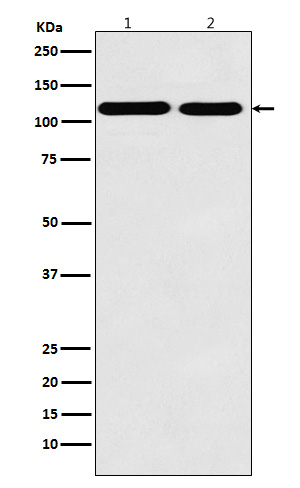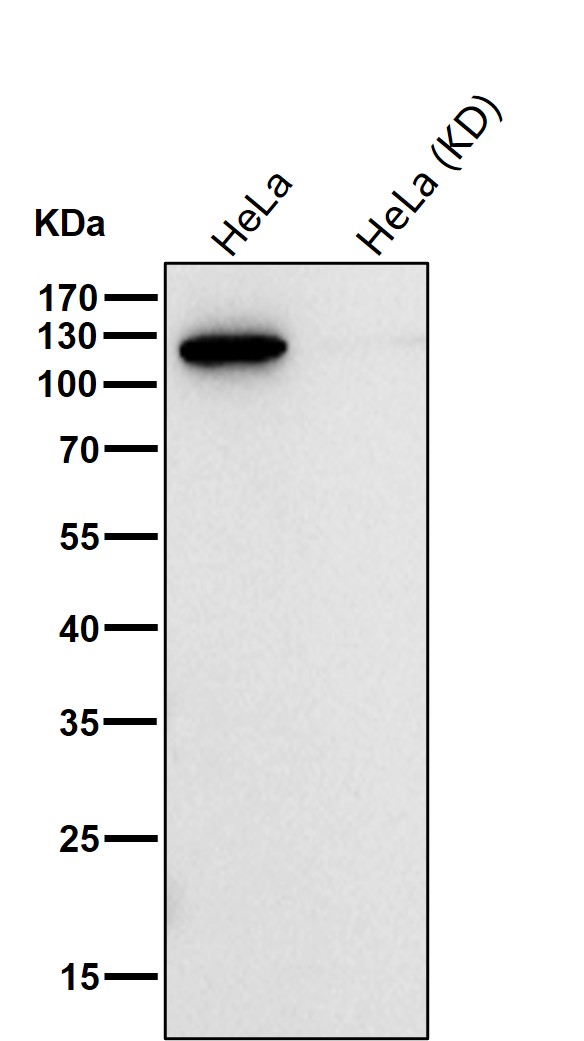

| WB | 咨询技术 | Human,Mouse,Rat |
| IF | 咨询技术 | Human,Mouse,Rat |
| IHC | IHC:1/100-1/200;IHF:1/50-1/200 | Human,Mouse,Rat |
| ICC | 1/50-1/200 | Human,Mouse,Rat |
| FCM | 1/20-1/100 | Human,Mouse,Rat |
| Elisa | 咨询技术 | Human,Mouse,Rat |
| Aliases | KIAA0723; Matr3; Matrin3; MPD2; VCPDM;;Matrin 3 |
| WB Predicted band size | Calculated MW: 95 kDa ; Observed MW: 125 kDa |
| Host/Isotype | Rabbit IgG |
| Antibody Type | Primary antibody |
| Storage | Store at 4°C short term. Aliquot and store at -20°C long term. Avoid freeze/thaw cycles. |
| Species Reactivity | Human,Mouse,Rat |
| Immunogen | A synthesized peptide derived from human Matrin 3 |
| Formulation | Purified antibody in PBS with 0.05% sodium azide,0.05% BSA and 50% glycerol. |
+ +
以下是关于Matrin3抗体的3篇参考文献,包含文献名称、作者及摘要内容概括:
---
1. **文献名称**:*Matrin3 binds directly to mRNA and regulates splicing in a phosphorylation-dependent manner*
**作者**:Coelho et al. (2020)
**摘要**:该研究探讨了Matrin3蛋白通过直接结合mRNA调控RNA剪接的功能,并利用特异性抗体验证其在细胞核内的定位。研究发现磷酸化修饰影响Matrin3与RNA的相互作用,提示其在神经退行性疾病中的潜在作用。
---
2. **文献名称**:*ALS-linked mutations in Matrin3 alter protein-protein interactions and impair mRNA processing*
**作者**:Johnson et al. (2018)
**摘要**:通过免疫共沉淀(Co-IP)结合Matrin3抗体,揭示了ALS相关突变导致Matrin3与RNA结合蛋白(如TDP-43)的相互作用异常,进而干扰mRNA代谢,可能促进神经变性病理。
---
3. **文献名称**:*Antibody-based profiling of Matrin3 reveals cytoplasmic aggregation in inclusion body myopathy*
**作者**:Nakamura et al. (2015)
**摘要**:利用Matrin3特异性抗体对包涵体肌病(IBM)患者组织进行免疫组化分析,发现Matrin3在细胞质中异常聚集,提示其错误定位可能与肌肉退行性病变相关。
---
如需更多文献或具体实验应用细节,可进一步补充说明!
Matrin3 is a highly conserved nuclear matrix protein encoded by the MATR3 gene, primarily localized in the nucleus where it plays critical roles in DNA repair, RNA metabolism, and chromatin organization. It contains two zinc finger domains and two RNA recognition motifs, enabling interactions with nucleic acids and multiprotein complexes. Matrin3 antibodies are essential tools for studying its expression, localization, and functional mechanisms in both physiological and pathological contexts. These antibodies are widely used in techniques like Western blotting, immunofluorescence (IF), and immunohistochemistry (IHC) to investigate Matrin3's involvement in transcriptional regulation, mRNA stability, and alternative splicing.
Research has linked Matrin3 mutations to neurodegenerative diseases, including amyotrophic lateral sclerosis (ALS) and frontotemporal dementia (FTD), making its antibodies valuable for exploring disease mechanisms. Commercially available Matrin3 antibodies are typically raised against specific epitopes, such as the N-terminal or C-terminal regions, and vary in host species (e.g., rabbit, mouse) and clonality (monoclonal/polyoclonal). Validation data, including reactivity in human, mouse, or rat samples, are crucial for ensuring specificity. Recent studies also utilize these antibodies to probe Matrin3's role in stress granule formation and viral replication, highlighting its multifaceted cellular functions. Proper controls, such as knockout cell lines, are recommended to confirm antibody specificity in experimental settings.
×